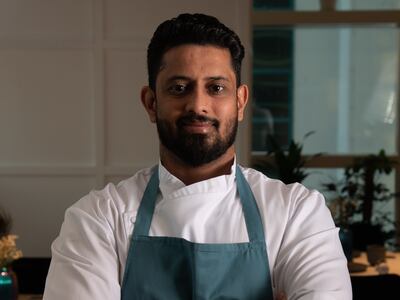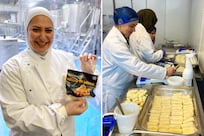Earlier this year, the Michelin Guide revealed its second crop of star-winning restaurants in Dubai.
A total of 11 venues received one star, three got two stars and 17 were listed under the Bib Gourmand category.
With the culinary and entertainment season well under way, The National continues its Star-grazing series and visits the latest Michelin-starred restaurants in Dubai to understand the ethos behind their celebrated menus.
The vegetarian-only Avatara, located in Dubai Hills, is our latest stop.
The story behind Avatara
It all started as a spin-off derived from a special menu at Tresind Studio, the two-Michelin-starred fine dining Indian restaurant, where Avatara chef Rahul Rana previously worked.
That menu shone a light on vegetables and non-meat products, he recalls, and it sparked an idea that has now been transformed into its own award-winning concept.
Avatara, a Hindustani word that loosely translates to incarnation, is the perfect embodiment for how Rana envisions the restaurant. The purely vegetarian dining spot alludes to India's vibrant agriculture industry.

The degustation menu comprises 16 dishes, which Rana describes as “soulful Indian food”. Each dish highlights a vegetable, and is not only packed with flavours, but also with stories.
What's on the Michelin-starred menu?
At first glance, a menu of 16 dishes in one seating feels like a lot. In theory, it helps that they are all vegetarian, and so perhaps lighter than meat dishes. In reality, this is a culinary journey that is opulent without being overwhelming.
The meal begins with naivedhya, or a holy offering, which sets the tone for what's to come. The bite-size appetiser contains panchamarita, a sweet nectar typically offered in temples. It is an explosion of flavours, quite literally, because of the carbonated sugar that pops in the mouth for a good few seconds.
The chef explains it is the best way to start a meal at Avatara, where guests are “treated like gods”, in line with the Indian principle of "atithi devo bhava". The plating of the dish, too, serves as a fitting prelude to Raha's remarkable attention to detail. It is garnished with edible flowers (another common temple offering) and served on a flamboyant bowl shaped like India's national bird, the peacock.
This palate tickler is followed by an aperitif: cucumber granita with beetroot sorbet and buttermilk. The small dish is a masterclass in combining different flavours: bitter, sour, salty and sweet.
This masterful blending is a common theme across the 16-course menu. To capitalise on the varying flavours, the chef has also completely removed garlic and onion from the menu.
“Although both these ingredients are commonly used in Indian cuisine, we don't use them at Avatara because they can easily overpower the other ingredients. We want our guests to really taste what they are having, and highlight the other vegetables we use,” Rana tells The National.
The rest of the dishes, too, include one star veggie each. The third, for example, is a tomato chaat. It is served on a sev cookie and comes with a sweet and sour shorba, a stew so flavourful, I can't help but request a refill.
Other dishes highlighting different fruits and vegetables include variations of roots dehydrated into chips and fritters made of lentils.
Another overarching element in Rana's menu is the use of “infamous vegetables”, such as bottle gourd and bitter gourd.
“People don't like these vegetables because of their nature. The bottle gourd is bland and the bitter gourd or karela is, well, bitter,” he says. At Avatara, you have no choice but to try them as it's a set menu, but believe me you won't regret it.
The bottle gourd is mashed into a paste-like texture, spiced and served on top of a poppadom waffle. There is nothing bland about it, from looks to taste.
The bitter gourd, too, is theatrical, cooked in ghee and served with mango gelato. The mixture of hot and cold is definitely interesting, and visually demonstrated by a red and light brown dosa crisp.

Meat eaters might be interested in the two dishes that imitate beef: A stuffed momo and a turnip steak. Rana nails the illusion, especially with the momo, which is filled with jackfruit, a common alternative to meat.
Another highlight of the menu is the horse gram curry served with hot, gluten-free bread. As the menu notes: “Horse gram, widely cultivated in [the chef's hometown] Uttarakhand, is highly nutritious and an excellent source of iron, calcium and phosphorus.”
Some of the dishes can get a little spicy, but the restaurant allows for modifications upon request.
The savoury dishes are followed by the first dessert, and a rather quirky one at that. It is a coconut kheer served on a male figurine holding a plate. As the evening progresses, the presentation gets more performative with two chocolate dishes, for which we won't spoil the surprise for.
The meal ends with a soothing jasmine and lychee tea, with the pot served next to a glass-covered rose a la Beauty and the Beast.
The 16-course menu is a showcase of Rana's cooking and plating skills. Despite the overwhelming number, the meal is not heavy, and the intrigue is maintained dish by dish.
Indian cuisine has a reputation for its rather strong use of spices, but Rana dials it down beautifully at Avatara – paying homage to the strong vegetarian roots of many Indian communities.
Avatara is open Tuesday to Sunday from 6pm-11pm, as well as for lunch on Sunday. The 16-course menu is priced at Dh450 per person






